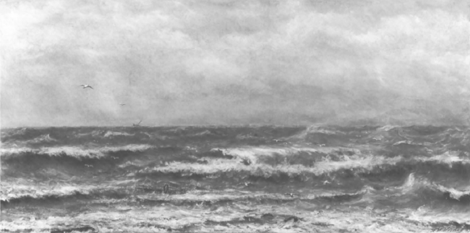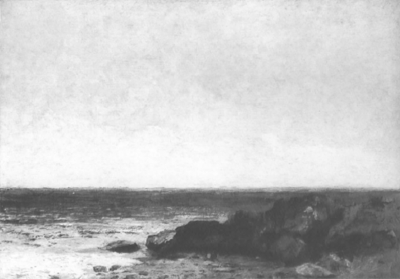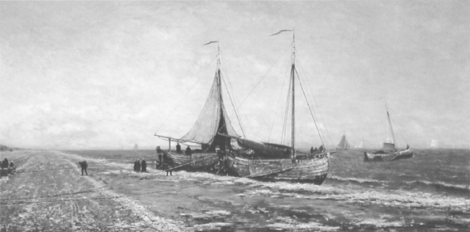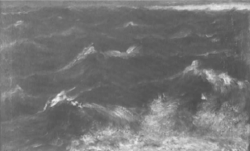Van Gogh Museum Journal 1999
(1999)– [tijdschrift] Van Gogh Museum Journal–
[pagina 104]
| |
 fig. 1
H.W. Mesdag, Breakers in the North Sea, 1869-70, Amsterdam, Van Gogh Museum | |
[pagina 105]
| |
Hendrik Willem Mesdag's Breakers in the North Sea (1869-70)
| |
[pagina 106]
| |
 fig. 3
Gustave Courbet, ‘La Méditerranée’: view of the Mediterranean at Maguelone, near Montpellier, 1858, Amsterdam, Van Gogh Museum been shown in Brussels - were rejected, and he felt it unwise to take the same risk with the Brussels Salon in July. Both his cousin, Alma-Tadema, and his colleague Verwée advised him against participating, feeling his work ‘was not yet sufficiently resolved.’Ga naar voetnoot3 In the end, though, Mesdag decided to hazard La saison des eaux, à l'île de Norderney (present location unknown). Four paintings by Gustave Courbet, the hero of the Brussels realists, were also on view at this event.Ga naar voetnoot4 One of these was a seascape, Les rochers noirs à Trouville (present location unknown), confronting Mesdag directly with a great model of marine painting. Having settled in The Hague, Mesdag immediately began to work on studies of the sea and landscape. The bad weather did nothing to deter him: ‘Nature is so beautiful here, but the weather has been awful so far.’Ga naar voetnoot5 He also immediately involved himself in The Hague art scene, showing at the Tentoonstelling van Levende Meesters. The titles of the pictures on display - What will become of | |
[pagina 107]
| |
them? (present location unknown) and A pastime: a view from the dunes on Norderney (present location unknown) - indicate that he was immersed in painting marines. This last picture was described by the well-known writer and critic Carel Vosmaer in a way that suggests Mesdag's sober realism seemed odd to his cultivated eye: ‘a piece of beach and sea, vertical and strangely cropped.’ He ironically renamed the other work - ‘a sea with a small boat with shipwrecked people floating about’ - ‘What will become of him?,’ a play on the young artist's uncertain reputation. The titles also demonstrate that Mesdag was not averse to including anecdote or narrative in his paintings. To Vosmaer, his entires were ‘an entirely unconditional confession of his faith in realism,’ which attested to ‘an extremely independent, audacious way of seeing.’ However, in order to become true art ‘this unshakeable pursuit’ had to avoid ‘asperity’ and be ‘tamed and controlled by one or more of the Graces.’Ga naar voetnoot6 This was the image Dutch art critics had of Mesdag from the very beginning, and one can certainly say that his brand of realism was relatively new to them. In Brussels he had moved in the circle of the Société Libre des Beaux-Arts, where the tenets of realism were dominant. Its heroes were Baudelaire and particularly Courbet, who had been made an honorary member.Ga naar voetnoot7 He had exhibited his notorious Stonebreakers (destroyed) at the Brussels Salon as early as 1851. His work had been shown there regularly ever since and he also paid frequent visits to the city.Ga naar voetnoot8 Verwée was even among his friends. It is hard to imagine Mesdag's development in Brussels and later in The Hague had he not been familiar with Courbet's ideas or never seen his paintings.
Unlike the seascapes Mesdag exhibited in The Hague in 1869, there are no anecdotal figures or any other kind of staffage in Courbet's seascapes (fig. 3). Whenever human figures do appear, their minuscule presence merely serves to emphasise the immensity of the space. Having seen one of Courbet's seascapes at the Brussels Salon, Mesdag decided to repaint the ‘large marine painting’, which he had begun at Norderney. His inspiration was the North Sea coast at Scheveningen which, being close to The Hague, he could study to his heart's content. He rented a room in the Villa Elba with a view of the sea.Ga naar voetnoot9 The reworking of this canvas must have been quite radical, and was likely carried out during the last few months of 1869. On 24 January 1870, however, he told Verwée that he had yet to finish this ‘grande marine,’ the work that was to become the Breakers in the North Sea. ‘You wouldn't recognise it,’ he wrote to his friend, who had seen the painting in its previous state on a visit to The Hague at the end of August.Ga naar voetnoot10 We know that in November 1869 Mesdag had still not decided whether he was going to submit anything at all to the Paris Salon. His hesitation was understandable; after all, he had been turned down on his previous attempt. It was only in March 1870 that he made up his mind to exhibit two paintings, one of which was to be ‘la grande marine’ - provided of course that they were not rejected ‘like the last time.’Ga naar voetnoot11 He sent his entries to the French capital via Brussels, where Verwée saw them at the art dealer Mommen's. He was not particularly impressed by the Journée d'hiver à Schéveningue, but thought the large seascape was ‘très bien,’ much to Mesdag's satisfaction. The artist, however, was unwilling to accept his friend's critique of the winter scene, and his defence of the painting says much about his methods and aims. Mesdag questioned whether Verwée had seen the painting ‘in a frame and properly lit.’ He then went on to explain the motif in detail, insisting that everything was true to life: ‘I have studied and painted this subject from nature and have tried to render the subject simply and naively, without attempting to turn it into a painting of dramatic gestures.’ The main effect he hoped to achieve was that of ‘a large space filled with light.’Ga naar voetnoot12 ‘Une grande espace pleine de lumière’ was certainly also what he strove for in the ‘grande marine.’ In the | |
[pagina 108]
| |
first place, he used a wide canvas, complying with the standard proportions for marine paintings - twice as wide as high - thus creating a panoramic effect.Ga naar voetnoot13 The same format reappears a number of times in Mesdag's oeuvre, for example in A winter's day at Scheveningen (fig. 4). This painting corresponds to the description of Journée d'hiver à Schéveningue in the letter to Verwée, and it seems highly probable that it was the other Salon entry of 1870, the pendent to Breakers in the North Sea. Another work of the same size is a View of Brussels, painted in 1868 (fig. 5). It reproduces a sweeping view from Mesdag's studio, created by first tracing onto transparent paper tacked to the window.Ga naar voetnoot14 The broad shape also emphasises Mesdag's hyperrealist intentions: these works were not carefully considered compositions but rather representations of the unhindered field of vision as such. There is no support for the edges of the painting, and the cropping on the left and right seems arbitrary. While still in Brussels Willem Roelofs had taught him that a landscape should to be cropped in this way, so that ‘the viewer does not notice it has been cut off, so that it continues in [his] mind.’Ga naar voetnoot15 In Breakers in the North Sea Mesdag has subtly organised the infinite and elusive seascape within this broad format. The point of view is low, and the horizon is located slightly below centre, leaving the breakers to dominate the sea almost completely. The painting thus represents the sea as seen by someone standing on the beach. The beach itself is invisible, but the drift in the surf indicates its presence at the viewer's feet. Mesdag depicts the waves crashing over each other, first in layers and then in long, diagonal folds. A little further in the distance, as they begin to break, their crests are blown away by the wind. At the centre, where two waves meet, the foam is depicted in the brightest white of the whole painting. Above, in a swirling, grey, stormy sky, an area of light answers to the foaming water below. It is what James Joyce would have called ‘a snot-coloured sea’: in its greyness it leaves every picturesque convention behind. And yet there are two traces of a human presence: driftwood from a shipwreck in the foam, and a ship clearly in difficulties on the horizon. While spatial points of reference are largely absent, these elements provoke reflection on the destructive force of the sea. Mesdag was probably aware that his choice of motif brought him into direct competition with his illustrious model, Gustave Courbet. Anna Croiset van der Kop states in her 1891 biography of Mesdag that ‘[he] had already heard about it.’Ga naar voetnoot16 Courbet had decided to submit a marine painting to the Salon in September 1869, when he was at Étretat on the Normandy coast.Ga naar voetnoot17 In his own words, both Courbet's entries, The stormy sea (Paris, Musée d'Orsay) and The cliff at Étretat (Paris, Musée d'Orsay) were ‘un succès monstrueux.’Ga naar voetnoot18 The reviews were favourable, though partly originating from the artist's own claque. His friend Jules Castagnary, for example, saw a ‘perfect accord between idea and execution’ in these pictures.Ga naar voetnoot19 The more moderate Georges Lafenestre spoke of vigorous brushwork, a grandness of aspect and a breadth of style.Ga naar voetnoot20 The conservative Wolff, however, suggested that these were merely studies and were unripe as works of art.Ga naar voetnoot21 In contrast the reviews of Mesdag's Breakers in the North Sea were lukewarm. Camille Lemmonier thought that the ‘overwhelming’ sea in Courbet's Stormy sea looked as if it had been ‘sculpted in glorious black marble, shot through with carmine red interwoven with threads of luminescent emerald green.’ Mesdag's waves, on the other hand, ‘lacked substance, and break limply; although they do spew beautiful tufts of foam.’Ga naar voetnoot22 According to his 1891 biography, Mesdag felt that Courbet's paintings at the Salon of 1870 were ‘clever’ and | |
[pagina 109]
| |
 fig. 4
H.W. Mesdag, A winter's day at Scheveningen, 1870, The Hague, Panorama Mesdag ‘powerfully expressed [...],’ but that they were insufficiently ‘based on nature.’ This, too, seems to indicate that Mesdag was both already familiar with Courbet's marine work and that in 1870 he was purposefully competing with the French painter.
Despite its unenthusiastic reception - and much to everyone's astonishment - Mesdag's Breakers in the North Sea was awarded a gold medal. Before it went to press, the Kunstkronijk made space available for a ‘very important announcement,’ namely, that H.W. Mesdag had won ‘the great gold medal.’ The misconception that Mesdag had won the gold medal has persisted ever since.Ga naar voetnoot23 However, the Livret of the Salon of 1872 states that he was only one of 40 artists to have received this particular accolade. The honour nevertheless came as a great surprise, not least because the members of the artists' society Pulchri Studio in The Hague - if we are to believe Johan Gram - had objected to Mesdag becoming even a ‘working member’ only the year before.Ga naar voetnoot24 Mesdag's own bewilderment | |
[pagina 110]
| |
 fig. 5
H.W. Mesdag, View of Brussels, 1868, The Hague, Panorama Mesdag is apparent from a letter to Verwée in which he thanked his friend for his good wishes: ‘You must certainly be as amazed as I am.’Ga naar voetnoot25 Mesdag was keenly interested in the Salon reviews and asked Verwée to keep him closely informed of what was being written.Ga naar voetnoot26 He could hardly wait to hold the medal in his hands and viewed the outbreak of the Franco-Prussian war as an irritating inconvenience, perfectly timed to obstruct the sending of his decoration. Finally, more than a year after it had been awarded him, Mesdag came up with the idea that a painter friend of his could bring it with him from Paris; whether or not this plan was carried out is not known. Since the medal is now in the Museum Mesdag (among all the many honours the painter received during his lifetime), however, it clearly made its way to him somehow. Mesdag repeatedly spoke of his award in his letters and insisted on being mentioned by dealers as a medal winner when he showed at their exhibitions.Ga naar voetnoot27 The artist would have been renouncing his mercantile origins if he had not immediately understood the consequences this award would have for his career and the price of his paintings. He considered it an opportune moment to adjust the values, and even his dealers accepted that the figures would rise as a result of his success. Mesdag sold the winning Breakers in the North Sea to ‘un amateur’ for 2,500 francs. The buyer was the genre and portrait painter Charles Chaplin, a member of the 1870 jury. Mesdag expected the sale to add extra shine to his medal in the eyes of the Dutch.Ga naar voetnoot28 He was extremely proud of the brief announcement of his prize signed by the famous painter Jean-François Millet. He had it framed, and it hung in his studio from that day on.Ga naar voetnoot29 Mesdag also received congratulations from Félix Ziem, another member of the jury.Ga naar voetnoot30
We do not know how or when the painting finally left Charles Chaplin's collection. It was no longer among his possessions by the time the artist's studio was auctioned in 1891.Ga naar voetnoot31 The only trace the heirs turned out to have was a photograph.Ga naar voetnoot32 It was not until 1991 that the researches of Johan Poort and his collaborator Robbert Ruigrok finally bore fruit. Two paintings, which appeared to be of the sea but to which a number of boats had been clumsily added, turned out to be the reworked parts of the original painting. The left half, moreover, had been given a false signature. | |
[pagina 111]
| |
The detailed examination of the materials that preceded the rejoining of the two halves confirmed that both had indeed been primed in the same way, and therefore incontestably belonged together. Furthermore, the various stages of the painting could be seen, and these matched perfectly with Mesdag's descriptions in his letters to Verwée.Ga naar voetnoot33 The careful observer can still see a slightly darker stripe slightly to the right of centre that witness to the mutilation of the painting by posterity. |
|


